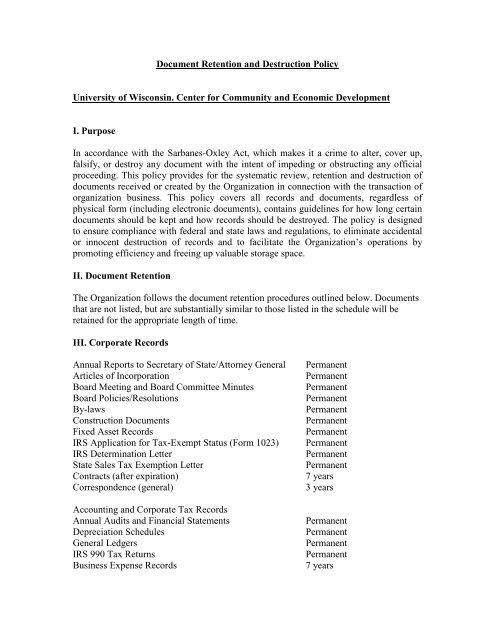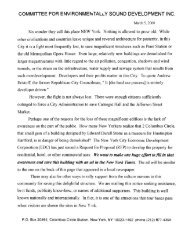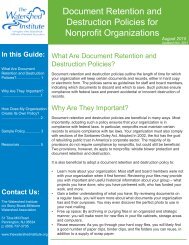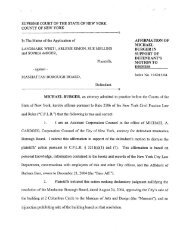Sample Document Retention and Destruction Policy
Sample Document Retention and Destruction Policy
Sample Document Retention and Destruction Policy
Create successful ePaper yourself
Turn your PDF publications into a flip-book with our unique Google optimized e-Paper software.
<strong>Document</strong> <strong>Retention</strong> <strong>and</strong> <strong>Destruction</strong> <strong>Policy</strong><br />
University of Wisconsin. Center for Community <strong>and</strong> Economic Development<br />
I. Purpose<br />
In accordance with the Sarbanes-Oxley Act, which makes it a crime to alter, cover up,<br />
falsify, or destroy any document with the intent of impeding or obstructing any official<br />
proceeding. This policy provides for the systematic review, retention <strong>and</strong> destruction of<br />
documents received or created by the Organization in connection with the transaction of<br />
organization business. This policy covers all records <strong>and</strong> documents, regardless of<br />
physical form (including electronic documents), contains guidelines for how long certain<br />
documents should be kept <strong>and</strong> how records should be destroyed. The policy is designed<br />
to ensure compliance with federal <strong>and</strong> state laws <strong>and</strong> regulations, to eliminate accidental<br />
or innocent destruction of records <strong>and</strong> to facilitate the Organization’s operations by<br />
promoting efficiency <strong>and</strong> freeing up valuable storage space.<br />
II. <strong>Document</strong> <strong>Retention</strong><br />
The Organization follows the document retention procedures outlined below. <strong>Document</strong>s<br />
that are not listed, but are substantially similar to those listed in the schedule will be<br />
retained for the appropriate length of time.<br />
III. Corporate Records<br />
Annual Reports to Secretary of State/Attorney General<br />
Articles of Incorporation<br />
Board Meeting <strong>and</strong> Board Committee Minutes<br />
Board Policies/Resolutions<br />
By-laws<br />
Construction <strong>Document</strong>s<br />
Fixed Asset Records<br />
IRS Application for Tax-Exempt Status (Form 1023)<br />
IRS Determination Letter<br />
State Sales Tax Exemption Letter<br />
Contracts (after expiration)<br />
Correspondence (general)<br />
Accounting <strong>and</strong> Corporate Tax Records<br />
Annual Audits <strong>and</strong> Financial Statements<br />
Depreciation Schedules<br />
General Ledgers<br />
IRS 990 Tax Returns<br />
Business Expense Records<br />
Permanent<br />
Permanent<br />
Permanent<br />
Permanent<br />
Permanent<br />
Permanent<br />
Permanent<br />
Permanent<br />
Permanent<br />
Permanent<br />
7 years<br />
3 years<br />
Permanent<br />
Permanent<br />
Permanent<br />
Permanent<br />
7 years
IRS 1099s<br />
Journal Entries<br />
Invoices<br />
Sales Records (box office, concessions, gift shop)<br />
Petty Cash Vouchers<br />
Cash Receipts<br />
Credit Card Receipts<br />
Bank Records<br />
Check Registers<br />
Bank Deposit Slips<br />
Bank Statements <strong>and</strong> Reconciliation<br />
Electronic Fund Transfer <strong>Document</strong>s<br />
7 years<br />
7 years<br />
7 years<br />
5 years<br />
3 years<br />
3 years<br />
3 years<br />
Permanent<br />
7 years<br />
7 years<br />
7 years<br />
Payroll <strong>and</strong> Employment Tax Records<br />
Payroll Registers<br />
Permanent<br />
State Unemployment Tax Records<br />
Permanent<br />
Earnings Records<br />
7 years<br />
Garnishment Records<br />
7 years<br />
Payroll Tax returns<br />
7 years<br />
W-2 Statements 7 years<br />
Employee Records<br />
Employment <strong>and</strong> Termination Agreements<br />
Permanent<br />
Retirement <strong>and</strong> Pension Plan <strong>Document</strong>s<br />
Permanent<br />
Records Relating to Promotion, Demotion or Discharge 7 years after termination<br />
Accident Reports <strong>and</strong> Worker’s Compensation Records 5 years<br />
Salary Schedules<br />
5 years<br />
Employment Applications<br />
3 years<br />
I-9 Forms 3 years after termination<br />
Time Cards<br />
2 years<br />
Donor Records <strong>and</strong> Acknowledgement Letters<br />
7 years<br />
Grant Applications <strong>and</strong> Contracts<br />
5 years after completion<br />
Legal, Insurance <strong>and</strong> Safety Records<br />
Appraisals<br />
Copyright Registrations<br />
Environmental Studies<br />
Insurance Policies<br />
Real Estate <strong>Document</strong>s<br />
Stock <strong>and</strong> Bond Records<br />
Trademark Registrations<br />
Leases<br />
OSHA <strong>Document</strong>s<br />
General Contracts<br />
Permanent<br />
Permanent<br />
Permanent<br />
Permanent<br />
Permanent<br />
Permanent<br />
Permanent<br />
6 years after expiration<br />
5 years<br />
3 years after termination
IV. Electronic <strong>Document</strong>s <strong>and</strong> Records<br />
Electronic documents will be retained as if they were paper documents. Therefore, any<br />
electronic files, including records of donations made online, that fall into one of the<br />
document types on the above schedule will be maintained for the appropriate amount of<br />
time. If a user has sufficient reason to keep an email message, the message should be<br />
printed in hard copy <strong>and</strong> kept in the appropriate file or moved to an “archive” computer<br />
file folder. Backup <strong>and</strong> recovery methods will be tested on a regular basis.<br />
V. Emergency Planning<br />
The Organization’s records will be stored in a safe, secure <strong>and</strong> accessible manner.<br />
<strong>Document</strong>s <strong>and</strong> financial files that are essential to keeping the Organization operating in<br />
an emergency will be duplicated or backed up at least every week <strong>and</strong> maintained off site.<br />
VI. <strong>Document</strong> <strong>Destruction</strong><br />
The Organization’s Executive Director is responsible for the ongoing process of<br />
identifying its records, which have met the required retention period <strong>and</strong> overseeing their<br />
destruction. <strong>Destruction</strong> of financial <strong>and</strong> personnel-related documents will be<br />
accomplished by shredding.<br />
<strong>Document</strong> destruction will be suspended immediately, upon any indication of an<br />
official investigation or when a lawsuit is filed or appears imminent. <strong>Destruction</strong> will<br />
be reinstated upon conclusion of the investigation.<br />
VII. Compliance<br />
Failure on the part of employees or contract staff to follow this policy can result in<br />
possible civil <strong>and</strong> criminal sanctions against the Organization <strong>and</strong> its employees or<br />
contract staff <strong>and</strong> possible disciplinary action against responsible individuals. The<br />
Treasurer will periodically review these procedures with legal counsel or the<br />
organization’s certified public accountant to ensure that they are in compliance with new<br />
or revised regulations.







